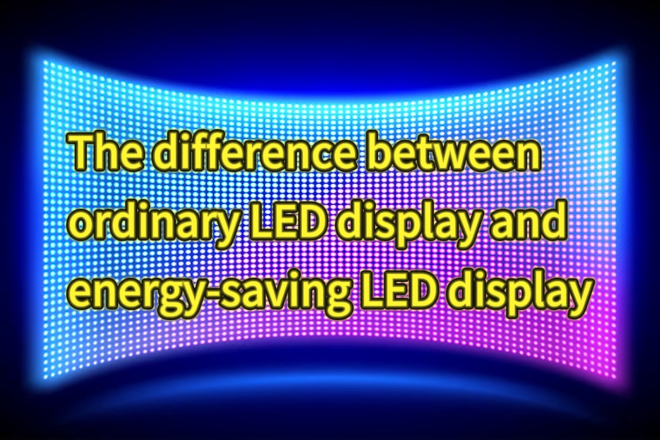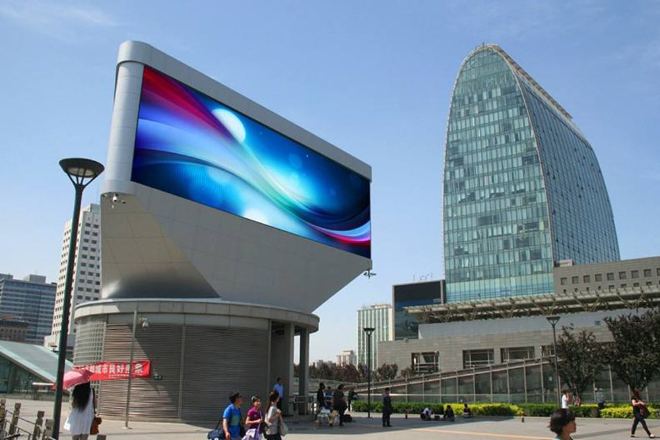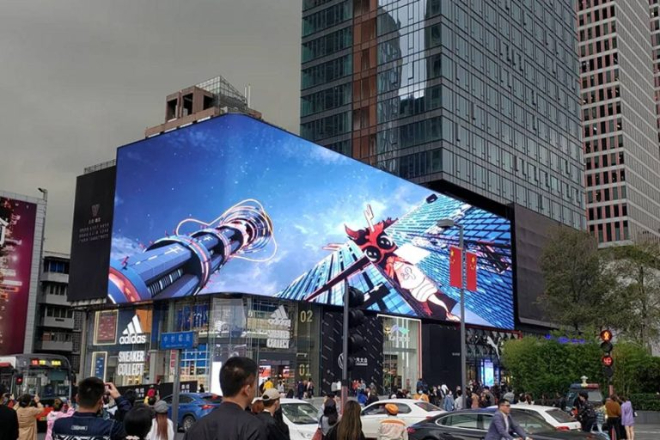介绍

In today’s digital age, LED显示屏 have been widely used in various fields, from commercial advertising to public information display, they are everywhere.
But did you know that there are significant differences between ordinary LED display screens and energy-saving LED display screens?
These differences not only affect the display effect, but also are related to cost and environmental protection. This article will explain the difference between these two types of display screens in detail.
目录
Difference 1: Basic principle and structure
1). Ordinary LED display screen
1.1). Basic principle
The working principle of an ordinary LED display screen is actually quite interesting. Simply put, it relies on LED lamp beads to emit light.
When current flows through the LED, the electrons inside will “activate” the semiconductor material, causing the atoms to release photons, which will produce light.
You can think of each LED lamp bead as a small pixel. By controlling the brightness and color of these lamp beads on and off, you can piece together a variety of images and texts.
In order to make the display brighter and clearer, ordinary LED display screens usually use a technology called pulse width modulation (PWM).
To put it simply, it is to make the LED lamp beads light up and off quickly, and adjust the brightness by controlling the frequency and time of this on and off. In this way, when we look at it with our human eyes, the picture will be more stable and will not feel flickering or blurry.
1.2). Basic structure
An ordinary LED display screen is actually like a “big canvas” composed of many small bulbs. These small bulbs are LED lamp beads, which are the key components of the display screen.
Imagine that many small bulbs are arranged closely together; each bulb can emit light of different colors, and when combined, various patterns and texts can be displayed.
In addition to the lamp beads, there are some important “helpers” in the display screen.
The first is the drive circuit, which acts like a “commander” to tell each lamp bead when to light up, when to turn off, and to what extent. If there is a problem with the drive circuit, the lamp beads may flash randomly or not light up.
The control board is like the “brain” of the display screen. It receives external signals (such as text or pictures to be displayed), and then decomposes these signals into instructions and sends them to the drive circuit.
Simply put, the control board determines what content the display screen will display.
The power supply system is also very important.
It is responsible for supplying power to the entire display screen, just like a “gas station” that provides energy to the machine.
If the power supply is unstable, the display screen may flicker or simply not work.
The function of the heat dissipation system is to prevent the display screen from overheating. LED lamp beads generate heat when working. If the heat cannot be dissipated, the lamp beads may burn out. Therefore, the heat dissipation system usually includes heat sinks and fans to help dissipate the heat.
Finally, the entire display screen also needs a sturdy frame to support it, just like a house needs a foundation.
This frame fixes all the components together to ensure that the display screen will not loosen or be damaged during use.
2). Energy-saving LED display screen
2.1). Basic principle
The energy-saving LED display screen is based on an ordinary LED display screen, adding some “smart” energy-saving technology to make it consume less power. The core trick is dimming technology.
Simply put, it is to save power by controlling the brightness of the LED. There are two common methods of dimming technology: one is to adjust the size of the current. If the current is small, the brightness is low; the other is to adjust the width of the pulse.
If the pulse is short, the brightness will also become dim. Through these methods, you can use as little electricity as possible while ensuring that the picture looks good.
Moreover, energy-saving LED displays also use some advanced power management technologies to make the power conversion efficiency higher and reduce the amount of electricity wasted during the transmission process.
In this way, not only can it save electricity, but it can also keep the performance of the display screen very good.
2.2). Basic structure
The energy-saving LED display screen has also made a lot of structural optimizations, mainly to save more electricity. First, more efficient light-emitting chips are used.
These chips can emit brighter light at the same current, with higher luminous efficiency, and naturally save more electricity.
Secondly, the heat dissipation system has also been improved, using better materials and designs to increase heat dissipation efficiency and reduce heat accumulation. This not only saves electricity but also allows the display screen to be used longer.
In addition, efforts have also been made in circuit design, such as using more efficient drive circuits and control boards to reduce energy loss in the circuit.
These improvements have improved the overall performance of energy-saving LED displays and achieved significant energy-saving effects.
Difference 2: Energy consumption comparison

1). From a theoretical perspective
The power consumption of ordinary LED display screens is about 200 watts/m2 to 800 watts/m2. For example, the common P2.5 indoor full-color screen consumes about 350 watts per square meter on average.
The outdoor P10 display consumes about 600 watts per square meter. Through some intelligent dimming technologies, these displays can save 30% to 40% of electricity.
Energy-saving LED display screens are much more powerful. Through some new technologies, such as high-efficiency LED chips (light efficiency>180lm/W) and dynamic energy-saving driving technology, its power consumption can be reduced to about 200 watts/m2.
This means that under the same brightness and display content, energy-saving LED display screens save much more power than ordinary LED display screens.
For example, suppose there is a 10-square-meter display screen that runs for 10 hours a day. Ordinary LED display screens (power consumption 600 watts/m2) consume about 60 kWh per day, while energy-saving LED display screens (power consumption 200 watts/m2) only consume 20 kWh per day.
In a month (30 days), ordinary LED display screens consume 1,800 kWh of electricity, while energy-saving LED display screens only consume 600 kWh. The energy-saving effect is obvious at a glance.
2). Energy consumption test in actual application
When professional laboratories and authoritative institutions test the energy consumption of LED display screens, they usually adjust the brightness to different levels at standard ambient temperature and then let the display screen run for a long time to see how much electricity it actually consumes.
For example, according to the SJ/T 11891-2023 standard, they will measure the energy consumption of the display screen at different brightness and display content to evaluate its energy efficiency.
The actual test cases are also very interesting. For example, an outdoor advertising screen can save 35% of electricity in a year after using the intelligent dimming system, and a single screen can save 100,000 kWh of electricity a year.
There is also an LED screen in the airport terminal, which can save 800,000 yuan in electricity bills a year through energy-saving transformation.
These actual test data show that energy-saving LED display screens are much more energy-saving than ordinary LED display screens in various scenarios, such as indoor advertising screens and outdoor large display screens.
Not only does it save electricity, but it can also save a lot of operating costs.
In short, whether from theoretical calculations or actual tests, energy-saving LED displays perform very well in terms of power saving and can help users save a lot of electricity bills.
Difference 3: Display effect difference
1). 亮度 调整
1.1). Ordinary LED display:
The way ordinary LED displays adjust brightness is a bit “rough”, mainly by changing the current size.
This method is fine when the brightness is high, but when the brightness is lowered, the screen color may become strange, such as yellowish or greenish, which looks awkward.
Moreover, the screen is prone to flickering at low brightness, which makes people tired of looking at it.
1.2). Energy-saving LED display:
Energy-saving LED displays are much smarter. They use a technology called pulse width modulation (PWM), which can make brightness adjustment very delicate.
No matter how low the brightness is adjusted, the color will not change or flicker. Whether it is under the sun or in the dark at night, energy-saving LED displays can keep the picture clear and comfortable.
2). Color performance
2.1). Ordinary LED display:
The color performance of ordinary LED displays is acceptable, but the details are a bit unsatisfactory.
For example, when displaying a high-definition landscape photo, the blue of the sky may not be deep enough, the green of the grass may not be bright enough, and the overall look is a bit “gray”.
Moreover, the color transition is not natural enough, and the details of the shadow part are easily lost.
2.2). Energy-saving LED display:
Energy-saving LED display is much better in this regard. It uses better light-emitting chips and drive circuits, with a wider color range and higher restoration.
For example, when displaying a photo of natural scenery, the energy-saving LED display can perfectly present the gradient color of the sky and the layering of vegetation.
The color transition is natural and the details are rich, which makes people feel comfortable.
3). 刷新率 and dynamic display effect
3.1). Ordinary LED display:
The refresh rate of an ordinary LED display is generally between 60Hz and 120Hz. When displaying fast-moving pictures, such as live sports events or e-sports, the picture may be trailing or blurred.
This is because the screen update speed cannot keep up with the speed of picture changes, just like when the handshakes when taking a photo, the picture does not look smooth enough.
3.2). Energy-saving LED display:
Energy-saving LED display can reach a refresh rate of 240Hz or even higher through technical optimization while ensuring energy saving.
This means that it can display dynamic images more smoothly, reduce tailing and blur, and make the picture look clearer and more coherent.
For example, when playing high-speed motion videos, the picture of an energy-saving LED display is like silky chocolate, while the picture of an ordinary LED display is like a bit of stuck sand.
In short, energy-saving LED display is better than ordinary LED display in brightness adjustment, color performance and dynamic display effect.
It can not only provide a more stable and natural display effect, but also meet various complex display requirements while saving energy. It is simply an “upgraded” LED display.
Difference 4: Service life and reliability

1). Life of light-emitting chip
1.1). Ordinary LED display:
The light-emitting chip of ordinary LED display will “age” after long-term use, mainly because the current is too large or the heat dissipation is not good. If the chip is always “fever”, the life will be shortened.
Ordinary LED display can theoretically be used for 50,000 to 100,000 hours, but in actual use, it may be “unusable” before this time.
1.2). Energy-saving LED display:
The chips used in energy-saving LED displays are of better quality and have a more reasonable heat dissipation design. These chips are like “aging-resistant” players, and they are not easy to “age” even if they are used for a long time.
Experimental data show that energy-saving LED displays can be used for more than 100,000 hours without any problems, and the brightness can be maintained very well.
For example, some high-end energy-saving LED display screens can be used for 10 to 15 years, which is much more “durable” than ordinary display screens.
2). Overall system reliability
2.1). Ordinary LED display screen:
The circuit and control system of ordinary LED display screens are relatively simple, and they are prone to “getting angry” when encountering voltage fluctuations or electromagnetic interference.
In high temperature, humidity or dusty places, ordinary LED display screens are prone to “getting sick” and malfunctioning.
2.2). Energy-saving LED display screen:
The circuit design of energy-saving LED display screen is more “smart” and has more protection measures. It is like a “stress-resistant” player, which can resist voltage fluctuations and electromagnetic interference and is not prone to malfunction.
Moreover, its shell has stronger protection ability and can prevent dust and water vapor from “invading”.
In harsh environments such as outdoor advertising screens, energy-saving LED displays can “stick to their posts” for a longer time, reducing the trouble of maintenance and replacement.
In short, energy-saving LED displays are more “reliable” than ordinary LED displays in terms of chip life and overall reliability. Not only can they be used for a long time, but they can also work stably in various environments, saving worry and effort.
Difference 5: Cost and cost performance
1). Initial purchase cost
1.1). Ordinary LED display:
The initial purchase cost of an ordinary LED display is relatively low. Why? Because its production process is relatively mature, and the materials and chips used are relatively ordinary.
It’s like buying an ordinary family car, which is relatively cheap but has relatively simple functions. The price of an ordinary LED display varies depending on factors such as brand, size, and 解决.
Generally speaking, the price of an ordinary LED display ranges from hundreds to thousands of yuan per square meter. However, after these screens are used for a long time, the performance may decline, and the life is relatively short.
1.2). Energy-saving LED display:
The initial purchase cost of an energy-saving LED display is higher. Why? Because it uses some more powerful energy-saving chips, efficient power supplies, and better heat dissipation design.
Although these high-end components can make the screen last longer and save more power, the price is also higher. It’s like buying a luxury car. Although it’s expensive, it has better performance and quality.
The high-efficiency LED chips (light efficiency>180lm/W) used in energy-saving LED displays are expensive, but they can significantly reduce long-term operating costs.
In addition, its shell protection is better and can adapt to harsher environments, which also increases the cost.
Generally speaking, the price per square meter of energy-saving LED displays may be about 30% to 50% higher than that of ordinary LED displays.
2). Operating cost and long-term cost performance
2.1). Ordinary LED display:
Ordinary LED displays are not cheap to use. Mainly electricity and maintenance costs. It’s like you bought an ordinary car. Although it was cheap when you bought it, the fuel and maintenance costs may give you a headache.
For example, for a 100-square-meter ordinary LED display, assuming that it consumes 600 watts of electricity per square meter and is driven 10 hours a day, the electricity bill for a year may cost tens of thousands of yuan.
Moreover, ordinary LED screens are prone to failure and are troublesome to repair, which increases the maintenance cost. Generally speaking, the failure rate of ordinary LED screens is relatively high and may require more frequent maintenance and replacement.
2.2). Energy-saving LED screens:
Although energy-saving LED screens are expensive to buy at first, they are much cheaper to use. For the same 100 square meters of screen, energy-saving LED screens may only consume 200 watts of electricity per square meter, which can save more than half of the electricity bill.
It’s like you bought a fuel-efficient car. Although it’s expensive to buy a car, you can save a lot of fuel in the long run. Moreover, this kind of screen has a low failure rate and less maintenance, so the maintenance cost is naturally low.
For example, after the LED screen of the airport terminal was transformed with energy-saving technology, it could save 800,000 yuan in electricity bills a year. This is not a small amount, and it can save a lot of money in the long run.
In some special cases, the advantages of energy-saving LED screens are more obvious. For example, in places where electricity bills are particularly expensive, energy-saving LED screens can help you save a lot of money.
Moreover, some places have subsidies for energy conservation and emission reduction, and you can get extra money by using energy-saving LED screens.
In the long run, energy-saving LED displays can not only help you save electricity bills but also reduce the trouble of maintenance and are very cost-effective.
Difference 6: Application scenarios and market trends

1). Application scenario comparison
1.1). Ordinary LED display screens:
Ordinary LED display screens are quite common in some old places. For example, the small advertising screens at the door of small shops can help to promote products and attract customers.
There are also 阶段 background screens, which can create dazzling visual effects during performances and make the audience shine. In these places, if you don’t care too much about electricity bills, ordinary LED display screens can still be used.
For example, in some small storefronts, ordinary LED display screens are cheap and easy to install.
However, if it comes to large outdoor advertising screens or urban landscape lighting, which have high requirements for energy saving and display effects, ordinary LED display screens are a bit “willing but not strong enough.”
1.2). Energy-saving LED display screens:
Energy-saving LED display screens perform particularly well in some trendy application scenarios. For example, intelligent traffic guidance screens can display road conditions in real-time and help drivers avoid detours.
There are also information release screens in 智慧城市 construction, which can efficiently disseminate various information, such as weather and news. These scenarios have high requirements for energy-saving and environmental protection, and energy-saving LED display screens come in handy.
It not only saves electricity but also operates stably in various complex environments and has a long lifespan.
For example, in places such as outdoor advertising screens that need to be lit for a long time, energy-saving LED displays can greatly reduce electricity bills and maintenance costs and are simply “money-saving experts.”
2). Market trends and development directions
2.1). Changes in market share:
In the past, ordinary LED displays were the “big brother” of the market, and they could be seen everywhere.
But as energy-saving LED display technology becomes more and more mature and the cost becomes lower and lower, the market share of energy-saving LED displays is climbing up little by little.
Now, more and more companies and projects are beginning to choose energy-saving LED displays, because it not only saves electricity, but also meets higher display requirements, which is simply an “upgraded version”.
2.2). Future development direction:
Looking back, LED display technology will develop in the direction of higher resolution, lower power consumption, and smarter.
Energy-saving technology will definitely become more and more important, and it will also “go hand in hand” with other new technologies.
For example, combined with the Internet of Things and artificial intelligence technology, more intelligent display control and energy management can be achieved.
This means that future LED displays will not only display clearer and more realistic pictures but also automatically adjust brightness and content according to the environment, just like having a “smart brain.”
Energy-saving LED display screens have a particularly broad market prospect under this development trend and are expected to shine in more fields in the future.
七、结论
Through the above comparison, we can see that energy-saving LED display screens are superior to ordinary LED display screens in terms of energy consumption, display effect, service life and other aspects.
Although its initial purchase cost is slightly higher, in the long run, energy-saving LED display screens can not only significantly reduce operating costs, but also provide better display effects and higher reliability.
最后,如果你想了解更多关于LED显示屏的信息, 请与我们联系。
